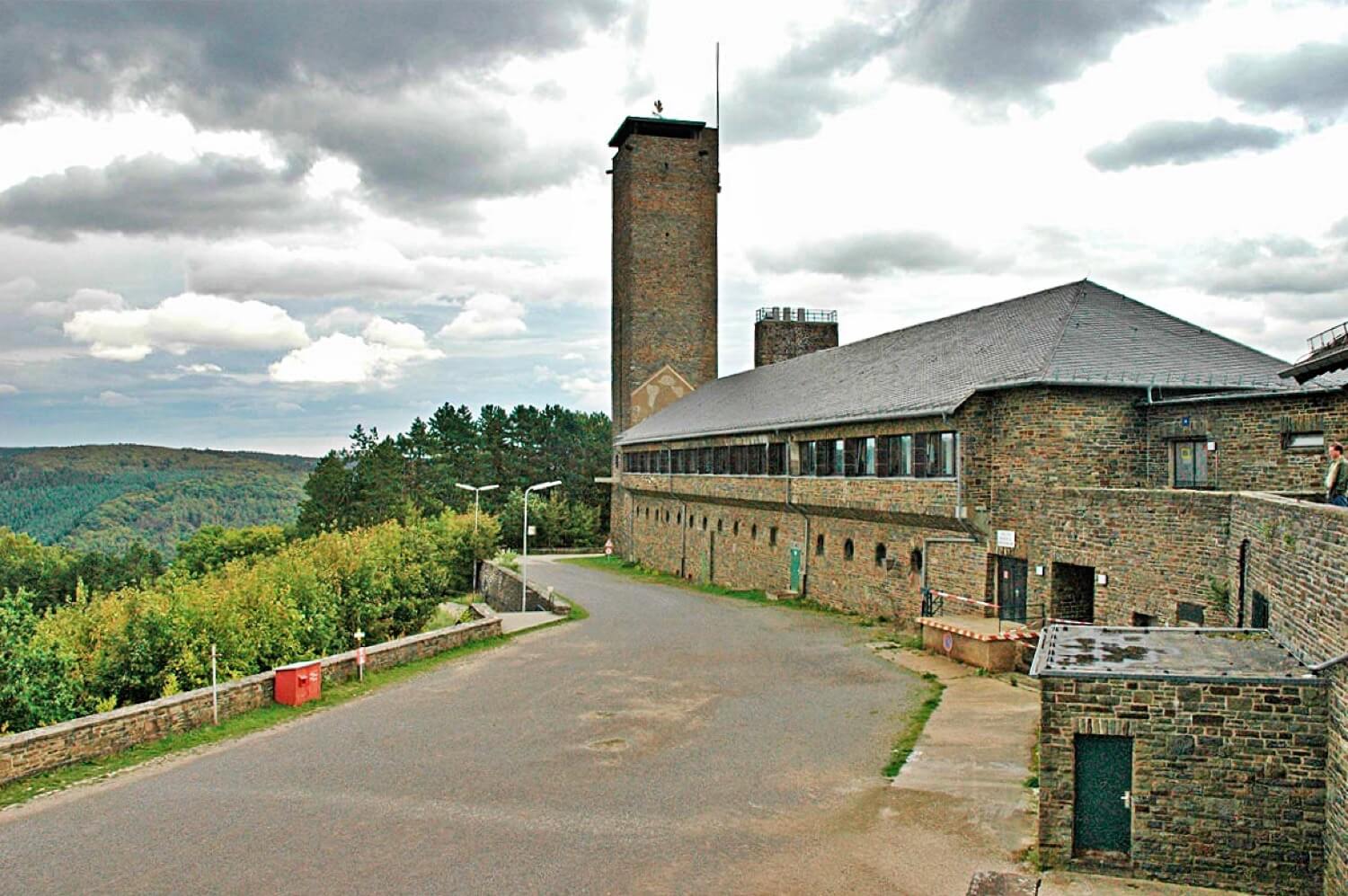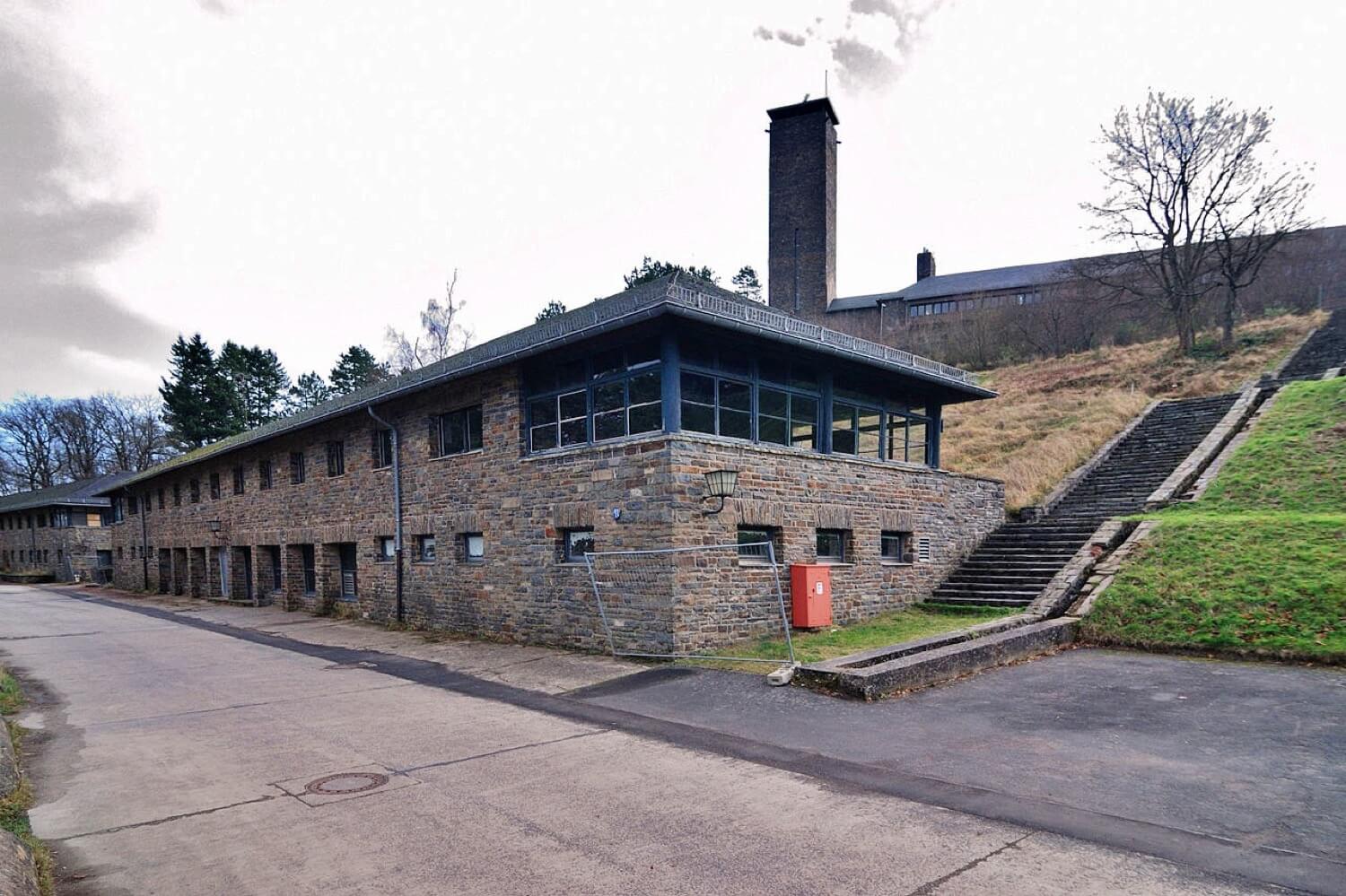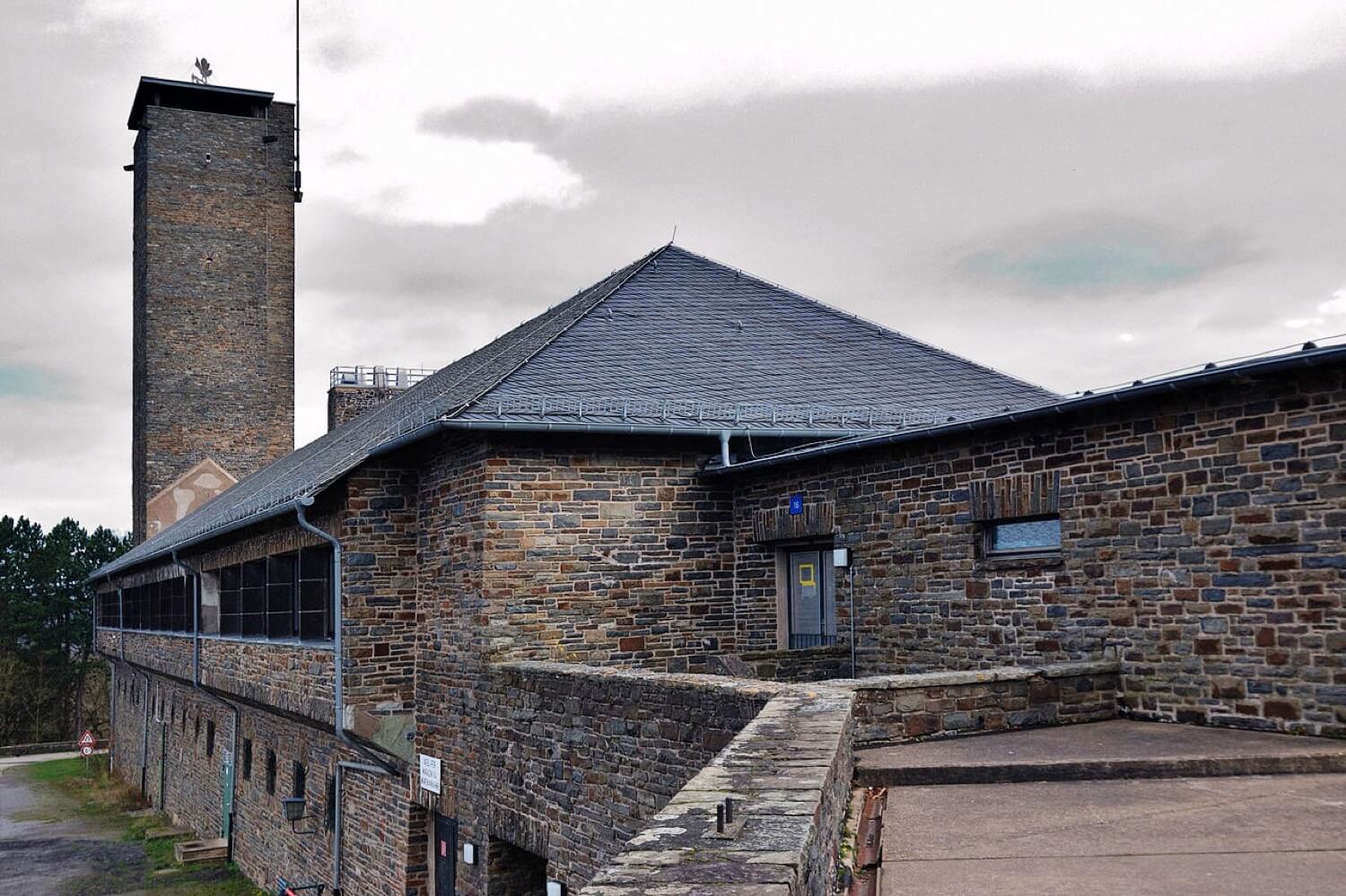Ordensburg Vogelsang
Köln Nordrhein-Westfalen Germany
castle, chateau
NS-Ordensburg Vogelsang
Köln Nordrhein-Westfalen Germany
castle, chateau
Ordensburg Vogelsang is a former National Socialist estate placed at the former military training area in Eifel National Park in North Rhine-Westphalia
Die NS-Ordensburg Vogelsang ist ein von den Nationalsozialisten in der Eifel oberhalb der Urfttalsperre auf dem Berg Erpenscheid errichteter Gebäudekomplex bei Schleiden-Gemünd in Nordrhein-Westfalen
Previous names
Ordensburg Vogelsang, NS-Ordensburg Vogelsang
Description
Ordensburg Vogelsang is a former National Socialist estate placed at the former military training area in Eifel National Park in North Rhine-Westphalia. The landmarked and completely preserved estate was used by the National Socialists between 1936 and 1939 as an educational centre for future leaders. Since 1 January 2006 the area has been open to visitors. It is one of the largest architectural relics of National Socialism. The gross area of the landmarked buildings is 50,000 m2.
In a 1933 speech in Bernau near Berlin, Adolf Hitler demanded that new schools be built for the children of the leaders of his national socialist German labour party (NSDAP). The task was given to Robert Ley, the "Reichsorganisationsleiter" (literally: Reich Organisational Leader) of the NSDAP, who undertook the construction and operation of four educational camps (NS-Ordensburgen):
Ordensburg Krössinsee, in Pomerania
Ordensburg Sonthofen, Allgäu
Ordensburg Vogelsang, Eifel
A fourth one was planned at (the historic) Ordensburg Marienburg, in West Prussia.
The construction of Ordensburg Vogelsang, most of which lies within the district of the town of Schleiden, was financed by expropriating trade unions and employers' associations. The contract for planning the Krössinsee and Vogelsang projects went to the Cologne architect Clemens Klotz.
The three buildings at Eifel have been known as "NS-Ordensburg" since 1935. The first phase of the project was the construction of the Castle of Vogelsang, which with up to 1,500 workers took only two years. Several much bigger buildings were also planned, such as a huge library to be called the "House of Knowledge" (Haus des Wissens) measuring 100 metres by 300 metres, a "Kraft durch Freude" hotel with 2000 beds, and the biggest sports facilities in Europe. Construction at the site halted on the outbreak of war.
Overview of the buildings
the entry area with gate and two towers (almost completed)
the "House of Knowledge" (Haus des Wissens) (only the foundation walls completed)
the "Community House" (Gemeinschaftshaus) with "Adlerhof" (literally translated: "eagle's yard"), tower, east wing and west wing (completed, partly destroyed in the war)
ten "Kameradschaftshäuser" (literally translated: comradeship-houses) for 50 pupils each (completed, partly destroyed in the war)
four "Hundertschafthäuser" (literally translated: houses of group of one hundred) for 100 pupils each (completed)
the Thingplatz as event stage (completed)
sports facilities with tribune, gymnasium and indoor swimming pool (completed)
the torch bearer (Feuermal Fackelträger) (completed)
the "House of female employees" (completed)
Most of the sculptures in Vogelsang - "Fackelträger" (torch bearer), "Der deutsche Mensch" (The German Man), "Adler" (Eagle) and the "Sportlerrelief" (sportsmen-relief) - were created by Willy Meller. The wood-sculpture "Der deutsche Mensch" disappeared in 1945. The other sculptures have been preserved, but are partly damaged.
After a visit by Adolf Hitler in 1937, Doric pillars without any static function were added to the entrance gate. According to reports, the initiative for that came from Hitler himself.
On 24 April 1936, the three Ordensburgen were formally handed over to Adolf Hitler, and the first 500 Orden Junkers (cadets) moved into Vogelsang a little later, arriving from all over Germany. Most were in their mid twenties, and entrance requirements included a period of probationary party work, perfect physical health, proof of descent, and proof of work and military service.
The daily timetable
6:00 early morning exercise
7:00 muster
8:00 - 10:00 project groups
10:00 - 12:00 lecture in the big auditorium
afternoons sport
17:00 - 18:30 project groups
22:00 rest
Emphases were national socialist race science, geopolitics and intensive sportive education (especially equitation). Another emphasis was pilot training, and to accommodate this phase of the curriculum airfields were built at all three Ordensburgen. The Vogelsang Airfield was built near Walberhof, near the town of Schleiden-Morsbach.
The Ordensburg Vogelsang was also used as a showplace for political notables.
At the outbreak of the war in September 1939, the Orden Junkers departed and the Castle of Vogelsang was handed over to the German army (Deutsche Wehrmacht), which used it twice for billeting troops: in 1940 during the western campaign, and in December 1944 during the Ardennes offensive.
During the interim, Vogelsang hosted a couple of classes of the so-called Adolf-Hitler-Schools. In 1944, a military fitness camp for 15- and 16-year-old members of the Hitler Youth (Hitler-Jugend) was held there. Allied air raids destroyed some of the buildings, including the east wing and the gymnasium.
The buildings destroyed during the war were reconstructed by the Belgian military authorities, and the surviving structures—reduced to bare brickwork—acquired a practical use. The foundation walls constructed for the House of Knowledge (Haus des Wissens) were used for the Van Dooren barrack block, and the adjacent basement, originally intended for an auditorium, became a cinema. This cinema has room for an audience of over 200. Of the decorations, only the emblems of the Third Reich—the swastikas—were removed.
After its period as a military training area came to an end, the former Ordensburg has been open to civilians since 1 January 2006. It can be visited during daytime. The surrounding area is used for hiking trails. The complex will eventually accommodate the administration of the National Park Eifel, the visitor centre, and an exhibition in the Castle. The "Van Dooren" barracks block will be demolished soon because the accommodations are no longer needed. The cinema and all the other buildings still exist.
In 2016 the German government said it would use some of the Vogelsang Barracks blocks to house migrant refugee claimants.
The latest stage of a £40 million facelift is the opening of an exhibition, aiming to educate the young against fascism. The display depicts how ordinary men and women were conditioned by the Nazis to hate Jews and others branded as inferiors.
Die NS-Ordensburg Vogelsang ist ein von den Nationalsozialisten in der Eifel oberhalb der Urfttalsperre auf dem Berg Erpenscheid errichteter Gebäudekomplex bei Schleiden-Gemünd in Nordrhein-Westfalen. Die Anlage diente, im Gegensatz zur SS-Junkerschule und zur Reichsführerschule, der NSDAP zwischen 1936 und 1939 als Schulungsstätte für den Nachwuchs des NSDAP-Führungskaders. Der unter Denkmalschutz stehende Teil der Bauwerke umfasst eine Bruttogeschossfläche von mehr als 50.000 Quadratmeter und gilt nach den Parteitagsbauten in Nürnberg mit fast 100 ha bebauter Fläche als die größte bauliche Hinterlassenschaft des Nationalsozialismus in Deutschland.
Nach dem Zweiten Weltkrieg wurde der Komplex von britischen Streitkräften übernommen, die im umliegenden Gelände auf 6354 ha den Truppenübungsplatz einrichteten. Von 1950 bis Ende 2005 wurde die Infrastruktur von belgischen Militärstreitkräften übernommen, die unter dem Namen „Camp Vogelsang“ dort eine Kaserne einrichteten und den Truppenübungsplatz nutzten bzw. verwalteten.
1933 forderte Adolf Hitler in einer Rede an der Reichsführerschule der NSDAP und der Deutschen Arbeitsfront in Bernau bei Berlin den Bau von neuen Schulen für den „Führernachwuchs“ der Nationalsozialistischen Deutschen Arbeiterpartei (NSDAP). Mit dem Bau wurde der „Reichsorganisationsleiter“ Robert Ley betraut. Ley gab den Bau dreier „Schulungslager“ (NSDAP-Ordensburgen) in Auftrag:
in Crössinsee (Pommern),
in Sonthofen (Allgäu) und
Vogelsang in der Eifel.
Finanziert wurde der Bau, der größtenteils auf der Gemarkung der Gemeinde Schleiden vollzogen wurde, aus Geldern der enteigneten Gewerkschaften und Arbeitgeberverbände.
Den Planungsauftrag für Crössinsee und Vogelsang bekam der Kölner Architekt Clemens Klotz. Am 16. März 1934 erfolgte der erste Spatenstich zum „Reichsschulungslager Vogelsang“. Die Bezeichnung NS-Ordensburg für die drei Bauwerke wurde erst ab 1935 üblich. Der Bau der Burg Vogelsang wurde im März 1934 begonnen und im ersten Bauabschnitt von bis zu 1500 Arbeitern innerhalb von nur zwei Jahren errichtet.
„Burgkommandant“ war zwischen dem 22. September 1934 und dem 1. Juli 1937 Franz Binz, der sich zuvor als Kreisleiter der NSDAP von Schleiden für den Bau eingesetzt hatte.
Zusätzlich zu den auf Vogelsang errichteten Bauwerken waren noch weitaus größere Bauten geplant. Unter anderem sollte ein gigantisches „Haus des Wissens“ als Bibliothek entstehen, das die vorhandenen Gebäude schon alleine mit seiner Grundfläche von 100 m × 300 m buchstäblich in den Schatten gestellt hätte. Darüber hinaus war ein „Kraft durch Freude-Hotel“ mit 2000 Betten geplant. Auf Vogelsang sollten zudem die größten Sportstätten Europas entstehen. Die teilweise bereits begonnenen Bauarbeiten wurden bei Kriegsbeginn eingestellt.
Folgende Bauwerke wurden geplant und teilweise auch ausgeführt:
Der Eingangsbereich mit Tor und zwei Türmen (größtenteils fertiggestellt),
Das Haus des Wissens (nur Sockelmauern fertiggestellt),
Das Gemeinschaftshaus mit Adlerhof, Turm, Ost- und Westflügel (fertiggestellt, teilweise kriegszerstört),
Die Burgschänke (fertiggestellt),
Zehn Kameradschaftshäuser für jeweils 50 Zöglinge (fertiggestellt, teilweise kriegszerstört),
Vier Hundertschaftshäuser für jeweils 100 Zöglinge (fertiggestellt),
Der Thingplatz als Veranstaltungsbühne (fertiggestellt),
Sportanlagen mit Tribüne, Turn- und Schwimmhalle (fertiggestellt),
Das Feuermal Fackelträger (fertiggestellt),
Das Haus der weiblichen Angestellten (fertiggestellt).
Unweit der Hauptgebäude, auf der anderen Talseite, auf halben Weg nach Wollseifen, war eine nationalsozialistische Mustersiedlung für die Bediensteten und die Verwaltung geplant. Es sollten 60 Mehrfamilienhäuser entstehen, einschließlich Schule und Kindergarten, ebenso ein Friedhof. Im Endzustand sollten über 4500 Menschen hier leben. Mit dem Beginn des Krieges wurden die Arbeiten eingestellt, 12 Häuser waren bereits gebaut. Nachdem Vogelsang zum Truppenübungsplatz wurde wurden die Häuser ebenso wie Wollseifen als Ziele benutzt und damit zerstört. Heute steht nichts mehr. Die letzten Reste wurden aus Unfallschutzgründen abgetragen und planiert.
Die meisten Plastiken in Vogelsang – Fackelträger, Der deutsche Mensch und das Sportlerrelief – stammen von Willy Meller. Während die Holzplastik Der deutsche Mensch 1945 verschwunden ist, sind die beiden anderen Plastiken – teilweise beschädigt – heute erhalten. (siehe Galerie)
Der Fackelträger am Thing-Platz (auch Sonnwendplatz genannt) ist eine 5 m hohe, martialisch-muskulöse Gestalt des nach der NS-Ideologie zu züchtenden arischen „Herrenmenschen“. Die Inschrift auf der Reliefplatte lautet: „Ihr seid die Fackelträger der Nation. Ihr tragt das Licht des Geistes voran im Kampfe für Adolf Hitler“.
Das Sportlerrelief (1938) aus roter Lava an der Stirnwand der Ehrentribühne ist stark verwittert und weist Schäden durch Einschusslöcher auf.
Nach einem Besuch Adolf Hitlers im Jahre 1937 wurde das Eingangstor mit dorischen Säulen ohne irgendeine statische Funktion ergänzt. Berichten zufolge ging die Initiative dazu von Hitler selbst aus. Darüber hinaus waren Teppichzyklen von Willy Meller, eine von Ferdinand Liebermann geschaffene Bronzebüste, Adolf Hitler darstellend, oder ein Intarsienbild von dem Kölner Bildhauer Josef Pabst ausgestellt. Ein Marmorputzmosaik von Ernst Zoberbier in der Schwimmhalle und ein Gobelin von Peter Hecker, Siegfrieds Tod und Der Kampf in Etzels Saal darstellend, vervollständigten die nationalsozialistische Propagandakunst, deren „Lehrmeister“ im Umfeld Werner Peiners und der Hermann Göring Meisterschule für Malerei zu suchen sind.
Am 24. April 1936 wurden die drei Ordensburgen in einem Festakt an Adolf Hitler übergeben. Wenig später rückten die ersten 500 NS-Junker auf Vogelsang ein. Die Lehrgangsteilnehmer kamen aus ganz Deutschland. Sie waren auf Vorschlag der Gauleitungen von Robert Ley handverlesen ausgewählt worden. Die meisten waren Mitte 20. Voraussetzung waren erste Bewährung in der Parteiarbeit, völlige körperliche Gesundheit, Arbeits- und Militärdienst sowie ein Abstammungsnachweis welcher bis ins 18. Jahrhundert zurückreichte. Weiterhin mussten die Bewerber auf Anordnung von Robert Ley verheiratet sein, dagegen interessierten ihre schulischen Leistungen überhaupt nicht. Den Bewerbern war bei ihrem Eintritt versprochen worden, dass sie nach Abschluss der Ausbildung jedes Regierungs- und Verwaltungsamt in Deutschland bekleiden könnten.
Der Stundenplan sah vor: 6:00 Uhr Frühsport, 7:00 Uhr Fahnenappell, 8:00 bis 10:00 Uhr Arbeitsgemeinschaften, 10:00 bis 12:00 Uhr Vortrag im großen Hörsaal durch Gast- oder Hauptlehrer, nachmittags Sport, 17:00 bis 18:30 Uhr Arbeitsgemeinschaften, 22 Uhr Zapfenstreich. In den Hauptvorlesungen zu den Themen Rassenkunde und „Geo-Politik“ wurden die Junker mit aggressiven außenpolitischen und rassistischen Thesen indoktriniert. Daneben gab es intensive sportliche Schulung, der Schwerpunkt dieser Ausbildung lag bei der Ordensburg Vogelsang auf dem Reitsport.
Die Lehrgänge auf den NS-Ordensburgen sahen auch eine Pilotenausbildung vor. Zu diesem Zweck wurden Flugplätze an allen drei Burgen gebaut. Der Vogelsanger Flugplatz entstand in der Nähe des Walberhofes, nahe der Ortschaft Schleiden-Morsbach. Auf Wunsch der Parteileitung in Berlin wurde die Ordensburg Vogelsang von insgesamt 16 Bunkern des Westwalls gesichert, deren Reste noch heute erkennbar sind und am 1. Dezember 2006 unter Denkmalschutz gestellt wurden.
Nach der Eröffnung des Schulbetriebs nutzte die politische Prominenz des Dritten Reichs Vogelsang auch als Repräsentationsort. Adolf Hitler sowie weitere führende Mitglieder des NS-Staates besuchten mehrfach die Ordensburg. Andere kamen zeitweise als Gastdozenten, so Theodor Oberländer, der spätere CDU-Bundesminister, im November 1936.
Beim Kriegsausbruch im September 1939 wurden der Schulbetrieb eingestellt, die Junker entlassen und zur Wehrmacht eingezogen. Die Burg Vogelsang wurde der Wehrmacht übergeben. Diese nutzte die Bauwerke zweimal als Truppenquartier: einmal beim Westfeldzug 1940, danach im Rahmen der Ardennenoffensive im Dezember 1944. Geübt wurde u. a. ab 1940 auf dem Truppenübungsplatz Elsenborn. Im Rahmen des Westfeldzuges wurde das Flugfeld am Walberhof mit einbezogen. Ab 1941 waren auf Vogelsang mehrere Klassen sogenannter Adolf-Hitler-Schulen untergebracht. Ab 1942 wurde das Haus für weibliche Angestellte zum „Heim für werdende Mütter“ umfunktioniert. Diese wurde aus dem Rheinland und der Eifel hierher evakuiert.
1944 bestand dort ein Wehrertüchtigungslager, in dem 15 bis 16 Jahre alte Jugendliche aus der Hitlerjugend militärisch ausgebildet wurden. Ende 1944 wurde eine Messerschmidt Jagdflugzeugstaffel auf Vogelsang stationiert. Durch alliierte Luftangriffe wurden einige Gebäude zerstört, darunter der Ostflügel und die Turnhalle.
Nach Ende des Zweiten Weltkrieges Anfang 1946 erwog die britische Militärverwaltung zeitweilig den Abriss der Ordensburg als herausragendes Symbol des Nationalsozialismus. Im September 1946 beschlagnahmten die Briten 6354 ha Land rings um die Ordensburg als Truppenübungsplatz. Die Bewohner mussten das Dorf Wollseifen räumen. Außer der Kirche und der Volksschule wurden alle Gebäude durch Schießübungen und Brände vollständig zerstört. Im Jahr 1950 wurde der Truppenübungsplatz („Training Area“ Vogelsang) mitsamt der ehemaligen Ordensburg von den Briten an die belgischen Streitkräfte übergeben.
Das belgische Militär nutzte das umgebende Gelände ab 1950 ebenfalls als Truppenübungsplatz und errichtete in der Anlage der ehemaligen Ordensburg weitere Gebäude, so den Unterkunftsblock „Van Dooren“, Tankstelle, Truppenunterkünfte für übende Truppen und weitere Nebengebäude zum „Camp Vogelsang“. Die Walburgiskapelle wurde im Eingangsgebäude eingerichtet. Bis ca. 1953 waren im Camp belgische Infanterie- und Artilleriesoldaten in Bataillonsstärke stationiert. Die Kasernenanlage diente aber im weiteren nur noch der mit ca. 250 zivilen und militärischen Kräften umfangreichen Übungsplatzkommandantur, dem Unterhalt der Kasernen und der Infrastruktur des Truppenübungsplatzes sowie der Aufnahme und Versorgung der übenden Truppen inkl. der Waffen und Geräte. Für den Bau der Soldatenunterkunft „Van Dooren“ wurden die bereits fertiggestellten Sockel- und Außenmauern des von den Nationalsozialisten geplanten Hauses des Wissens genutzt, so dass der gewinkelte Baustil dem Bau der Gebäude aus der NS-Zeit ähnelt. Auf dem benachbarten Fundament eines geplanten Hörsaales wurde das belgische Truppenkino (später Theater) errichtet.
An der Ordensburg Vogelsang selbst wurden von der belgischen Militärverwaltung behutsame Rekonstruktionen der kriegszerstörten Bausubstanz vorgenommen. Beseitigt wurden nur die Hoheitsabzeichen des Dritten Reiches, meist Hakenkreuze.
Das Flugfeld Walberhof (Graspisten), bereits von der NS-Ordensburg bzw. Wehrmacht genutzt (siehe oben), wurde bis 2006 von der belgischen Armee für leichte Flugzeuge und Helikopter betrieben. 1963 stürzte hier eine Piper Cub L-18C der belgischen Heeresflieger ab. Der Pilot und ein Begleiter kamen zu Tode.
Mit Gründung der NATO 1956 und Aufnahme der Bundesrepublik Deutschland übten, neben den Soldaten aus Belgien, auch NATO-Einheiten der Niederlande, des Vereinigten Königreichs Großbritannien und Nordirland, aus Frankreich, Luxemburg, den Vereinigten Staaten von Amerika, Deutschland und Kanada auf dem durch das belgische Militär verwalteten Übungsplatz. 1960 wurde das Übungsgelände auf 4200 ha verkleinert. Von 1957 bis 1975 gab es ein deutsches Verbindungskommando, von 1997 bis 2005 einen Deutschen Militärischen Vertreter (DMV), die innerhalb der Kasernenanlage stationiert waren. Zum Jahresende 2005 endete die militärische Nutzung von „Camp Vogelsang“.
Nach Aufgabe des Truppenübungsplatzes steht das Areal der ehemaligen Ordensburg mit den gewaltigen Bauwerken seit dem 1. Januar 2006 einer zivilen Nutzung offen und kann tagsüber besichtigt werden. Ein Teil der umliegenden Flächen ist durch Rad- und Wanderwege erschlossen. Seit Herbst 2009 verbindet die Victor-Neels-Brücke über den Urftsee – eine 150 m lange Stahlkonstruktion, benannt nach dem belgischen Kommandanten von Camp Vogelsang von 1970 bis 1980 – Vogelsang mit dem Rad- und Wanderwegenetz zwischen Urft-Sperrmauer, Gemünd und dem Kermeter.
Seit dem 1. Januar 2006 ist die Anlage wieder der Öffentlichkeit als „Internationaler Platz Vogelsang ip“ zugänglich, nachdem in dem erweiterten Militärgelände der Nationalpark Eifel, der erste in Nordrhein-Westfalen, errichtet worden war.
Derzeit befindet sich die Anlage Vogelsang noch im Besitz des Bundes, soll aber mit Unterstützung der Landesregierung auf den Kreis Euskirchen übergehen.
Die 2005 gegründete Vogelsang ip gemeinnützige GmbH hat sich die Umgestaltung und die Erarbeitung verschiedener neuer Nutzungskonzepte der gesamten Anlage zur Aufgabe gemacht. Nachdem zunächst nur kleinere Baumaßnahmen durchgeführt wurden, lief vom 23. April 2012 bis zum 11. September 2016 (Ausstellungseröffnung) der Umbau der ehemaligen Ordensburg zu einem Ausstellungs- und Bildungszentrum mit einer NS- und einer Nationalparkausstellung sowie einem neuen Besucherzentrum
Ein temporäres Besucherzentrum mit Restauration wurde bereits 2006 in der ehemaligen Kantine der Burg (Ostflügel) eingerichtet und 2008 erweitert.
2011 wurde das belgische Truppenkino aus den 1950er Jahren saniert. In diesem befand sich sodann bis zur Fertigstellung des neuen Forums das temporäre Besucherzentrum.
Im neuen geschaffenen, nun zentrales Besucherzentrum (s.o. Geländeplan, Nr. 10), wurden im September 2016 auf 800 m² die Dauerausstellung Bestimmung: Herrenmensch. NS-Ordensburgen zwischen Faszination und Verbrechen zur Geschichte der NS-Ordensburg in Verknüpfung mit allgemeinen Themen des Nationalsozialismus eröffnet. Eine große Nationalpark-Ausstellung sowie zusätzliche Wechselausstellungen in den bisher leerstehenden und ungenutzten Kellerräumen der Ordensburg informieren die Besucher.
Vom Adlerhof führt ein neuer Eingang zu den neu gestalteten Kellerräumen in Form einer mit einem Glasaufbau überdachten Treppe. Dieser Entwurf wurde auf Basis der Ergebnisse eines internationalen Architekturwettbewerbs im Jahr 2008 ausgewählt.
Das ehemalige Kino soll nach den Umbauarbeiten für Veranstaltungen genutzt werden und zudem neben den bereits heute zu Tagungszwecken genutzten Räumen des Forums West und Ost Kernstück eines neuen Tagungszentrums werden.
Es finden regelmäßig (meist täglich) mehrsprachige Führungen für Gruppen und Privatpersonen statt. Zudem finden regelmäßig Besteigungen des 48 m hohen Turmes statt, von dem die Besucher einen guten Ausblick auf den gesamten Nationalpark genießen können. Zudem wurden sämtliche Gebäude und Skulpturen durch gelbe Informationstafeln erklärt und zwei Rundgänge (Hang- und Plateaurundgang) ausgeschildert.
Das Jugend-, Natur- und Umweltbildungshaus Transit 59 des Roten Kreuzes, das Rotkreuz-Museum Vogelsang ip und das restaurierte Kino aus den 50er Jahren sind eröffnet und mit jeweils eigenen Bildungsprogrammen belebt.
Das Hallenschwimmbad aus der NS-Zeit, das auch das belgische Militär nutzte, sollte nach 2006 ursprünglich in eine Bar verwandelt werden, wurde aber erhalten, restauriert und wird durch den lokalen Schwimm- und Sportverein Vogelsang aus Schleiden wieder genutzt. Es ist Teil der umfangreichen Sportanlage, deren Sanierung noch bevorsteht.
Unklar ist hingegen die Zukunft der belgischen Kasernengebäude Van Dooren. Aufgrund der hohen Unterhaltungskosten könnte das nicht genutzte Gebäude mittelfristig abgerissen werden (außer den Fundamenten aus der NS-Zeit).
Es ist geplant, die Verwaltung des Nationalparks Eifel in den Gebäuden des „Malakoff“ genannten Torbereichs im Eingang zur Anlage unterzubringen.
Außerhalb der Ordensburg, im ehemaligen Truppenlager Schelde von Camp Vogelsang, werden seit Anfang 2017 Flüchtlinge untergebracht.
Nearby castles
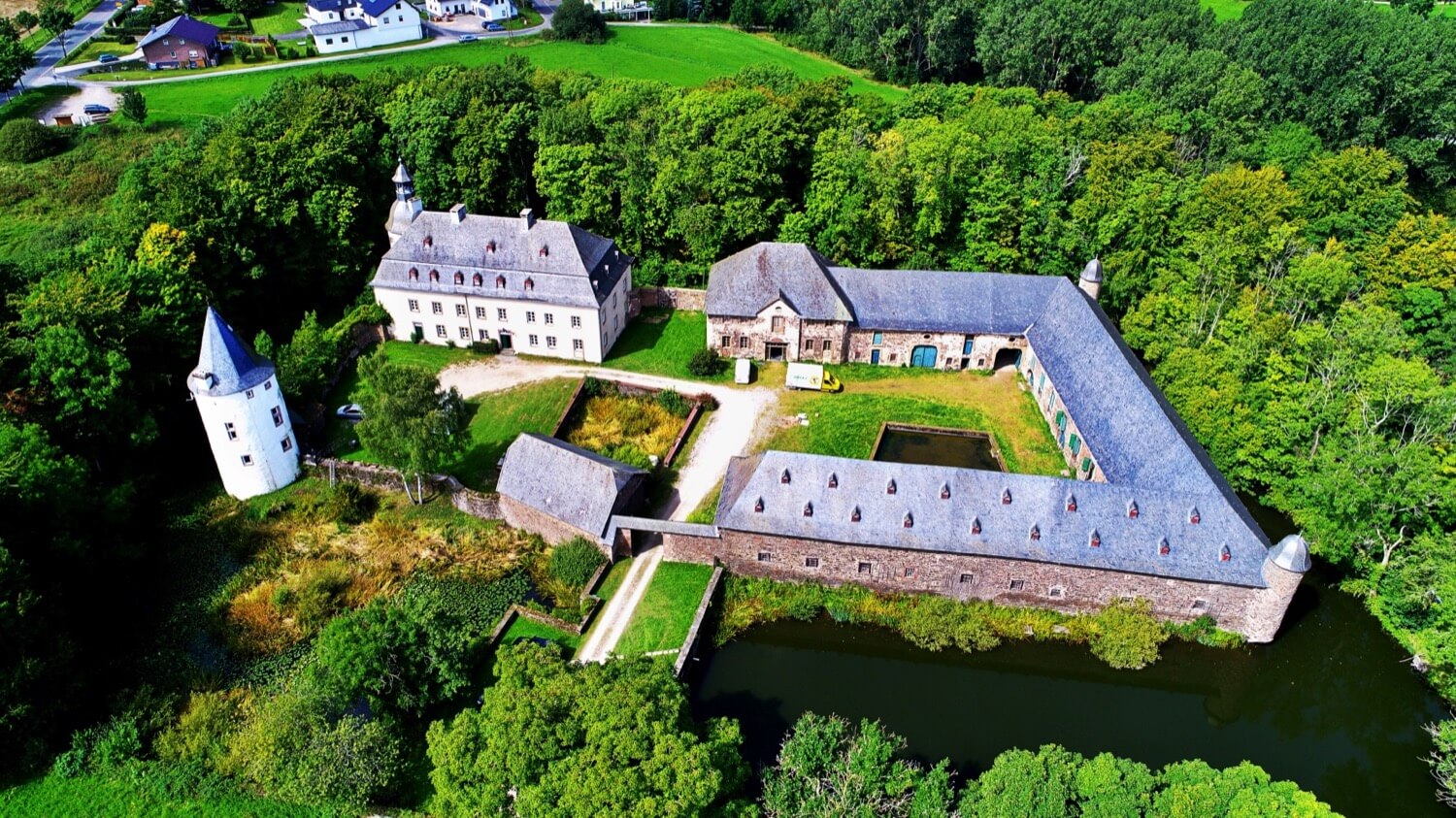
Burg Dreiborn
Köln
4.7km
castle, chateau
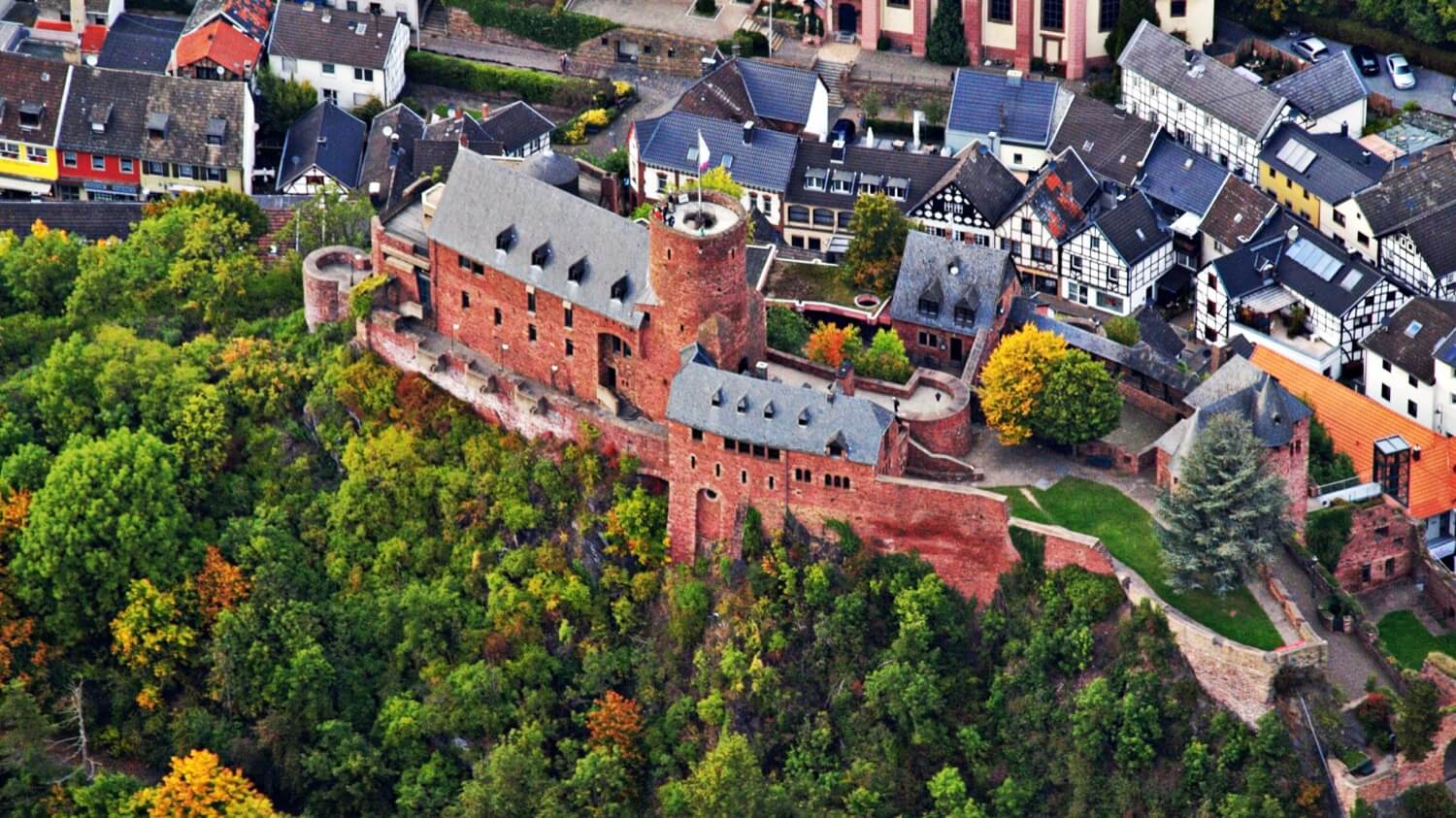
Burg Hengebach
Köln
5.9km
castle, chateau

Schloss Schleiden
Köln
6.5km
castle, chateau
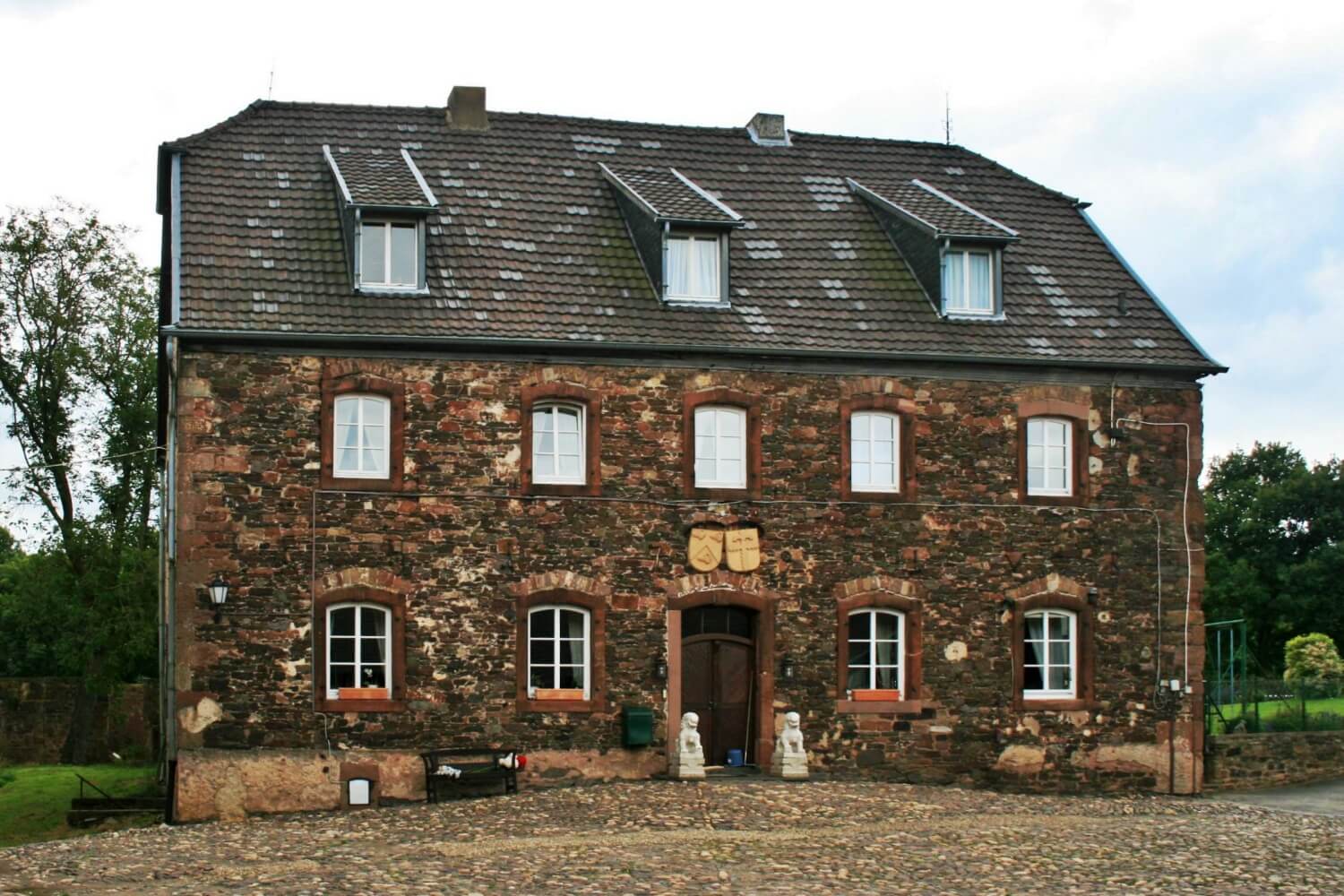
Blens Castle
Köln
8.7km
castle, chateau
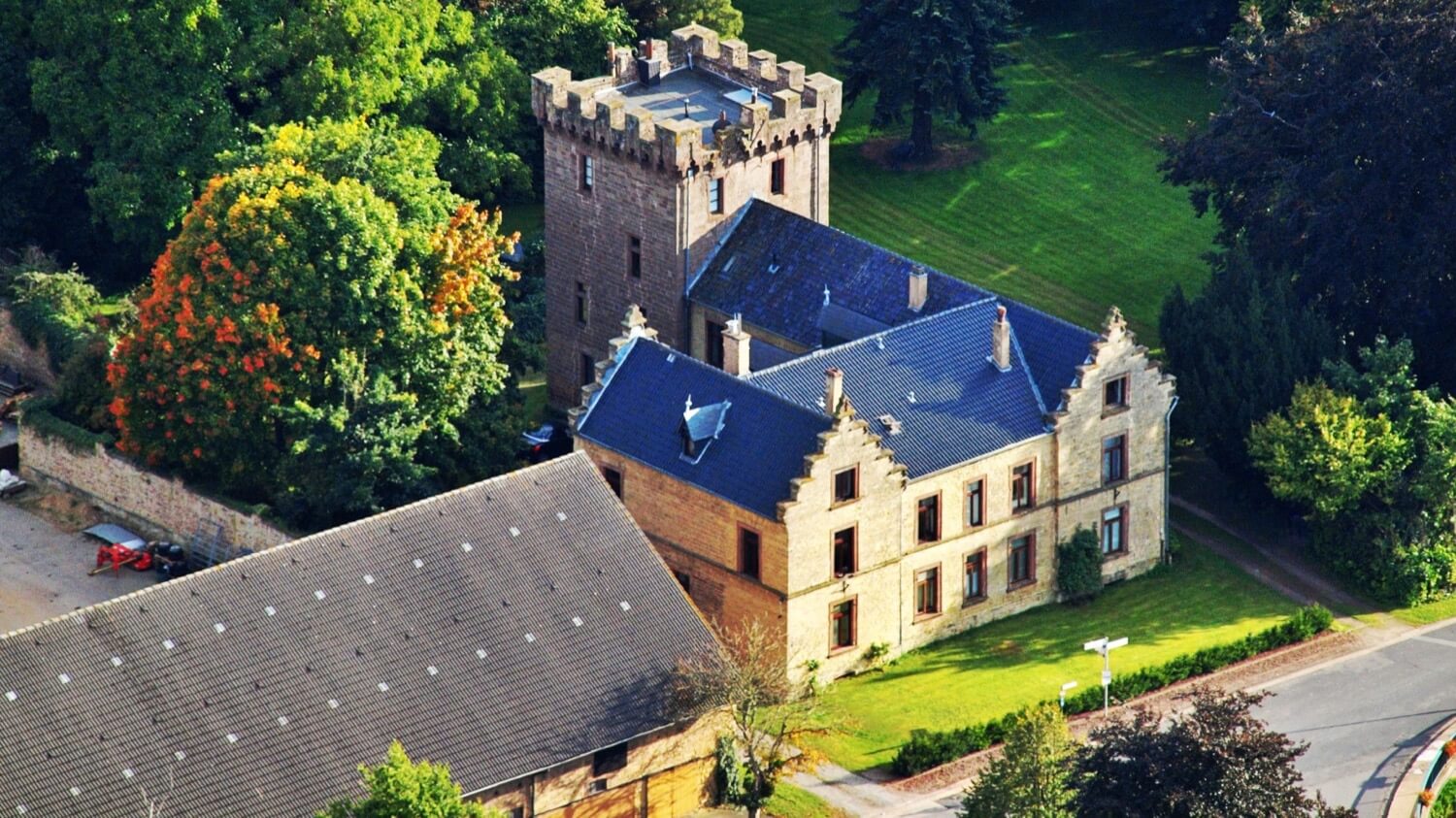
Burg Vlatten
Köln
10.2km
castle, chateau

Burg Nideggen
Köln
11.8km
castle, chateau
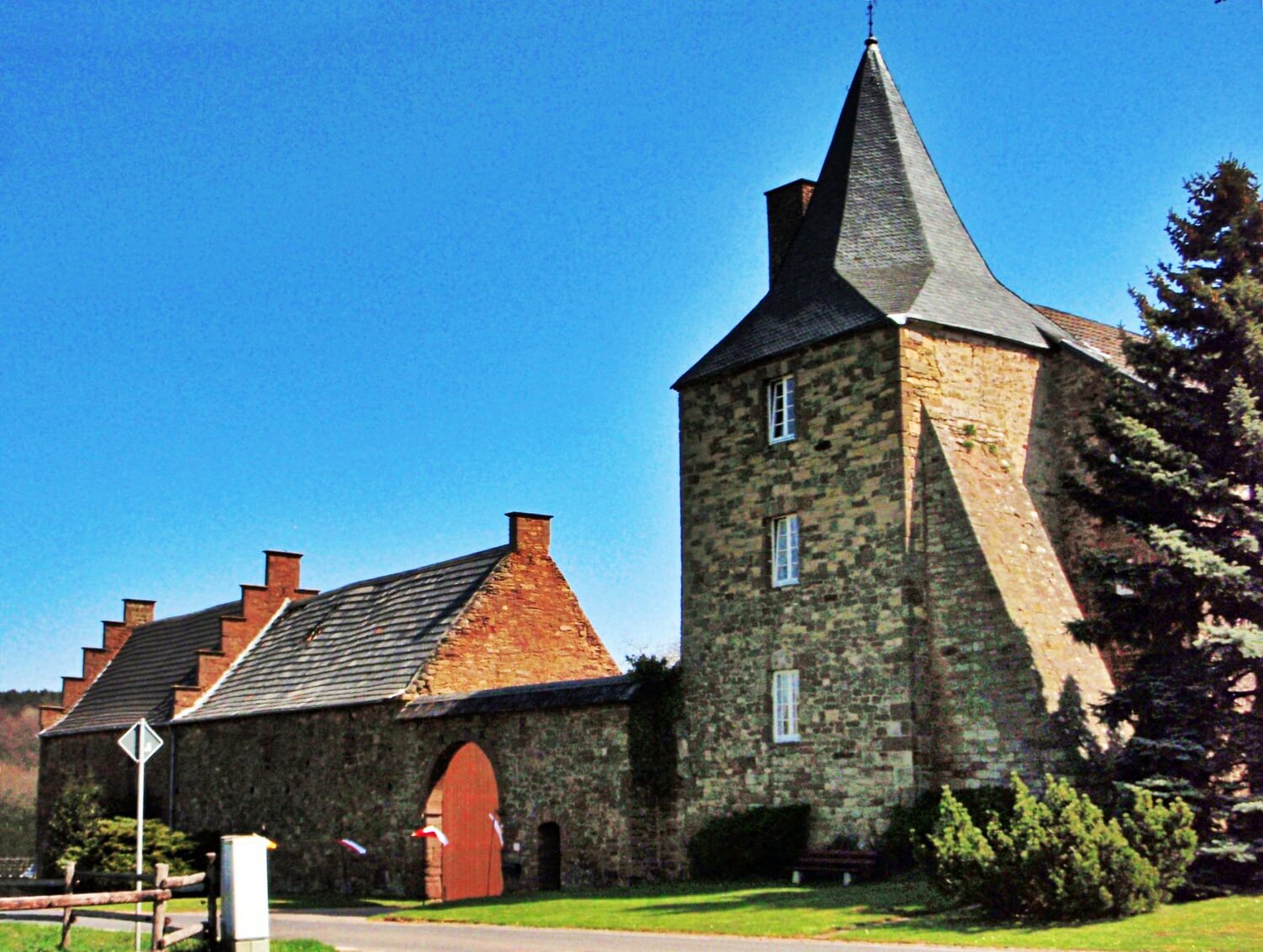
Burg Berg (Mechernich)
Köln
11.8km
castle, chateau
